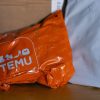Remarkable new images from the Odysseus mission capture the spacecraft — the first US-made vehicle to make a soft touchdown on the moon in five decades — in the moments directly after its harrowing and historic touchdown on the lunar surface.
Intuitive Machines, the Houston-based company that developed the Odysseus lander, shared the photos at a news briefing Wednesday. During the news conference, officials from Intuitive Machines and NASA — which paid to fly science instruments on the mission — also confirmed that all of Odysseus’ instruments are transmitting data, leading them to declare the mission successful despite significant setbacks during the spacecraft’s dramatic descent to the surface.
Mission controllers were celebrating the success, cheering “what a magnificent job that robust, lucky lander did all the way to the moon,” said Intuitive Machines CEO Steve Altemus.
The spacecraft was still transmitting data from its resting place near the moon’s south pole as of Wednesday afternoon.
Odysseus experienced navigation issues in the hours leading up to its touchdown on the moon’s surface last Thursday. And when the vehicle reached its destination — landing in an eroded crater near the largely unexplored lunar south pole — it tripped on the surface, leaving the spacecraft leaning on its side, Intuitive Machines revealed Friday.
“We sat there upright with the engine firing for a period of time and then as (the engine) wound down, the vehicle just gently tipped over,” Altemus said.
As of NASA and Intuitive Machines’ news briefing on Friday, the state of spacecraft and all of its science instruments was not yet clear.
But officials revealed Wednesday that Odysseus has beaten the odds — delivering data from all six NASA instruments as well as payloads from commercial companies, including a dual-camera observatory from Toronto-based company Canadensys Aerospace.
Many of the instruments on board Odysseus were designed to collect information as the spacecraft was in transit to the moon and during the crucial moments of descent toward the lunar surface. NASA’s Navigation Doppler Lidar, or NDL, for example, went from being an experimental instrument taking a test flight to becoming a critical mission-saving instrument in the final hours before Odysseus made its touchdown.
“The big goal was to land your equipment softly so you could get data from it after you land — and that was done successfully,” said Joel Kearns, the deputy associate administrator for exploration in NASA’s science mission directorate.
Altemus added: “In our mind, this is an unqualified success.”
All the data Odysseus is sharing
One of the NASA payloads — called SCALPSS, or the Stereo Cameras for Lunar Plume-Surface Studies — was designed to study how the lunar soil reacted to Odysseus’ engine as it descended toward the moon.
That instrument did not collect data during the spacecraft’s touchdown because of a hardware issue, according to Sue Lederer, a project scientist at NASA’s Johnson Space Center in Houston.
Despite the setback, teams on the ground were able to troubleshoot the SCALPSS instrument to begin dispatching data. All the other instruments on board Odysseus have functioned and relayed information for engineers and scientists to peruse, officials said Wednesday.
It’s not clear exactly when Odysseus, also called “Odie” or IM-1, will power down, but the spacecraft’s landing site will soon shift into a period of lunar night, a dangerous situation for the vehicle as the swing into ultra-freezing temperatures can cause damage. Altemus said that the lander could stop transmitting data on Wednesday night.
“We are projecting a time where the solar power generation will not allow Odie to continue sending down telemetry,” Altemus said. “But we will put (the vehicle) to sleep and expect to wake (Odie) up here in the next two or three weeks.”
Odysseus’ trip to the moon follows closely on the heels of two other missions: India’s Chandryaan-3, which brought a lander to the same region as Odysseus (though not as close to the pole), and Japan’s SLIM, which landed a spacecraft nicknamed “Moon Sniper” closer to the equator. Moon Sniper recently reawakened after it experienced lunar night, though Chandryaan-3 has not.
Working through challenges
The fact that Odysseus came to a rest on its side left a couple of its antennas pointed in an inopportune direction. That forced engineers on the ground to figure out a way to download as much data as possible — an ongoing effort in mission control.
The expected times of various Odysseus milestones have been moving targets.
Much is still unknown about the moon’s south pole, the region where the spacecraft landed. NASA and other institutions are heavily interested in this area because it’s believed to be home to stores of water ice, a critical resource that could provide drinking water for astronauts or even rocket fuel for future missions.
In addition to becoming the first American vehicle to land on the moon since Apollo 17 in 1972, Odysseus is also the first private spacecraft — designed and built by a commercial company — to make a soft landing on the moon.
Intuitive Machines launched the Odysseus mission as part of NASA’s Commercial Lunar Payload Services, or CLPS program, an effort by the space agency to robotically explore the moon using landers developed by the private sector before NASA returns its astronauts there as soon as later this decade.







































